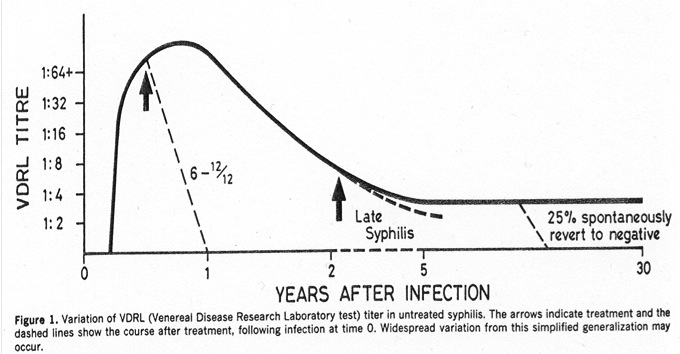An ongoing dialogue on HIV/AIDS, infectious diseases,
June 18th, 2012
ID Learning Unit — Serologic Tests for Syphilis
Diagnosing syphilis is tricky for lots of reasons, including:
- The protean disease manifestations, many of which were best described in older medical literature — and hence not known to people who don’t read words on paper (vs a screen) very often.
- You can’t visualize the bug (Treponema pallidum), unless you happen to have a darkfield microscope nearby — which, if you’re like 99.99% of clinicians, you don’t have at all.
- You can’t culture the bug, unless you use a rabbit — and all I can say about the various techniques of xenodiagnosis is yuck.
- There is a seemingly endless list of available serologic tests, each having a potentially different purpose and all of them carrying an indecipherable acronym.
It’s this last one that is the topic of today’s ID Learning Unit. All you need to know (not everything you could know) about blood tests for syphilis.
There are the screening tests:
- Rapid Plasma Reagin (RPR) — detects antibodies not to T pallidum, but to cardiolipin-cholesterol-lecithin antigens, which are present in active syphilis; which begs the question, what the heck is a “reagin”, and how do you pronounce it? Lots of false positives.
- Venereal Disease Research Laboratory (VDRL) — detects antibodies to the same antigens, just a different technique, and seems to be used much less often; test of choice in the CSF, where it’s believed to be specific (but not sensitive) for neurosyphilis. Of course, how we know that is very mysterious, just like everything about neurosyphilis.
- Treponema pallidum enzyme immunoassay (TP-EIA) — the new kid on the block and, finally, a screening test that actually looks at specific treponemal antigens — hence more specific, fewer false positives. The TP-EIA is replacing the RPR and VDRL as a screening test in many high-volume settings (hospitals, STD clinics, etc); we switched to it at our hospital a few years ago.
Next, there are the confirmatory tests:
- Fluorescent treponemal antibody absorption (FTA-ABS)
- Microhemagglutination test for antibodies to Treponema pallidum (MHA-TP)
- Treponema pallidum particle agglutination assay (TP-PA)
All positive screening tests must be confirmed with one of these confirmatory tests (our state lab does the TP-PA). It’s particularly important for the RPR and the VDRL because, as noted above, these tests measure antibodies to non-specific antigens and have lots of false positives. Hey, weren’t you listening?
 And finally, we bring back a couple of the screening tests to measure disease activity:
And finally, we bring back a couple of the screening tests to measure disease activity:
- RPR (mostly)
- VDRL
Both of these rise shortly after the lesion of primary syphilis (the chancre), then peak during secondary syphilis. Treatment hastens their decline, but some people will spontaneously revert to negative even without treatment (see figure, which is from an ancient but excellent paper, Ann Intern Med 1986;104:368). Which is why the above screening tests (RPR and VDRL) may be unreliable in evaluation of that elderly patient with dementia, and why they don’t really measure disease activity for late manifestations of syphilis. So if you really think it might be neurosyphilis, you should order TP-EIA or one of the confirmatory tests, listed above.
Two small digressions about the RPR and VDRL. First, the units. When positive, these tests are reported in dilutions — e.g., 1:4 is a one-dilution lower (and a two-fold lower) titer than 1:8. Not many of our tests get reported this way (ANA comes to mind as another); in general, it’s only considered a significant change if it’s two dilutions or more — 1:16 goes down to 1:4 after treatment, for example.
Second, they may be falsely negative due to the “prozone” reaction, which does not refer to place to buy auto parts. The prozone reaction occurs when the the antigen and antibody bind together forming a complex, blocking the clumping that labs look for when doing an RPR or a VDRL. If labs are alerted to the possibility of a prozone effect, they can do dilutions to reveal the expected agglutination.
All very simple, right? Hey, it’s topics like this that keep ID doctors in business!


Nice summary of syphilis testing.